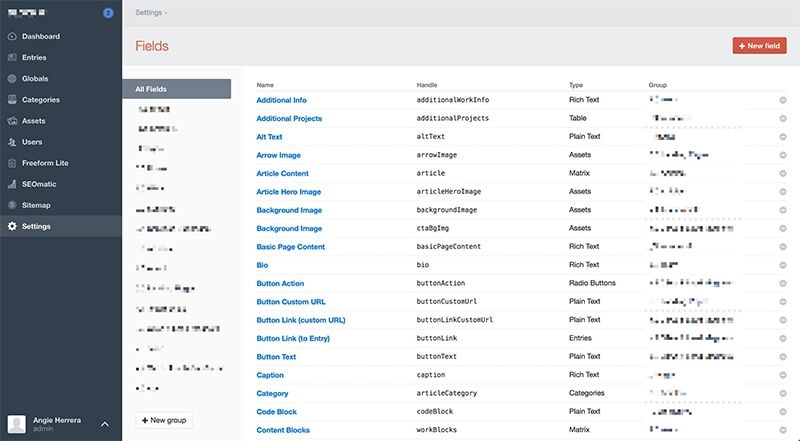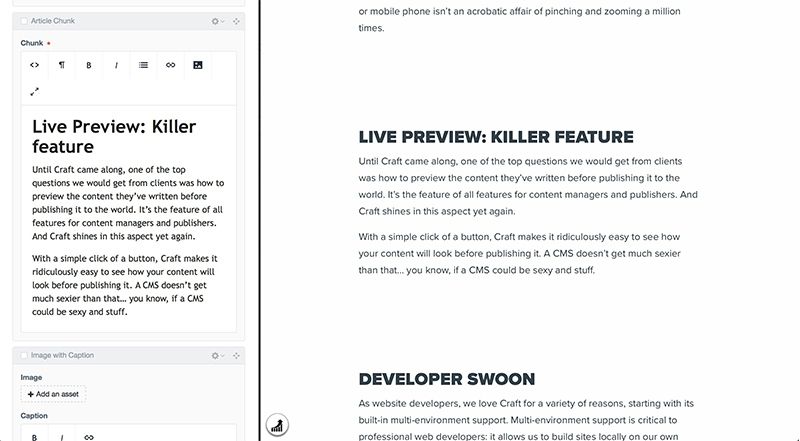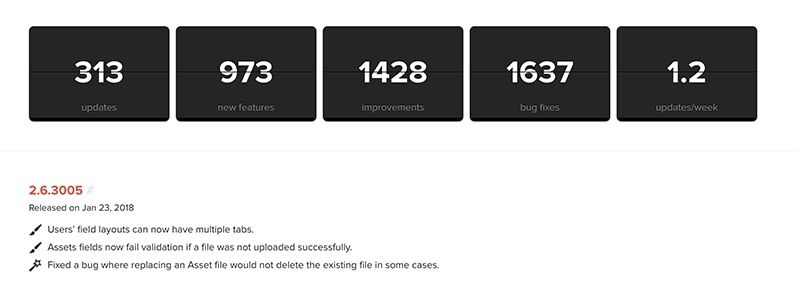Craft: My Preferred CMS
Craft is the content management system this Portland web design and development studio loves. Here's why.
I’ve said it before and to many people who have asked me: I don’t believe there’s a one-size-fits-all CMS. There’s just no such thing – no best CMS.
Every site is unique and has different parameters and requirements. A content management system should fit those requirements rather than trying to squeeze them into a CMS that may not accommodate them easily (with or without plugins, custom or otherwise).
Of course, that doesn’t mean I, like other web designers, don’t have my favorites. I have a few that I have experience in and that I feel round out the vast majority of client needs. One of those is Craft.

I've been using Craft pretty much since the beginning of its public existence. I knew it’d be a good CMS when I first heard about it because the folks behind it are Pixel & Tonic — the same team that created some integral and well-supported add-ons for my other favorite CMS, ExpressionEngine.
Since those early days, Craft has matured immensely and quickly. As a result, it’s quickly risen to the top of my list. And here are a few reasons why.

Powerful out of the box
Most CMSs are built with a core set of features and have an ecosystem of first- or third-party plugins that extend or add functionality. How much is in that core set can really make a difference though. With Craft, it’s ridiculous how much you get out of the box. Here are a few highlights that put Craft so high up on our list:
- Field types galore! Having various field types as a core part of the system makes it a breeze to plan for all kinds of content that can give clients quite a bit of control regarding their messaging.
- Image resizing. With websites needing to be fast on any number of devices (think small mobile phones all the way up to large monitors and TVs), images can make or break the user experience. Craft’s built-in image transformations make this so much easier.
- Versioning and drafts. A lot of websites are managed by multiple people require a publishing workflow. Right out of the box, Craft allows for people to create and save drafts and versions of virtually any page or piece of content.
- User management. Speaking of publishing workflows and people, Craft’s user management allows for finely tuned permissions. This is perfect for allowing different user groups to publish (or just edit) to different areas of a site.
- Multi-language. Having a site in multiple languages can be a nightmare to manage and often requires a clunky third-party plugin. Not so with Craft. Built right into the system, having a multi-language site is ridiculously easy.
To sum up, one of the best things about Craft is that it doesn’t need a ton of plugins to get the most common website features up and running. This is essential to keeping budgets and development time reasonable.
Flexibility
A lot of content management systems on the market, even in 2018, force developers to work within a relatively rigid templating or theming system. This, in turn, often limits designers in terms of what can or can't be done while still enabling content to easily and intuitively be managed.
While there are always limits to any system, Craft really is head and shoulders above most, if not all, CMS platforms in this realm. It doesn’t care what your site looks like or how it’s coded. All it cares about is what content needs to be managed and how it gets output on the front-end. This is huge for designers and developers alike.
This is also a big deal for content writers. Craft can handle pretty much any type of content you throw at it. Yes, even editorial layouts. How’s that for flexible?
A beautiful control panel that gets out of the way
Web designers and content strategists are virtually always going on and on about how good user experience is critical to a website. The same is true for an app such as a content management system. And again, Craft rises above most CMS platforms in this arena.
The Craft UI is pleasant to use — it gets out of the way and allows you to focus on your content. Full stop.
And if you’re on the road, the UI is also responsive, so editing on your tablet or mobile phone isn’t an acrobatic affair of pinching and zooming a million times.

Live Preview: Killer feature
Until Craft came along, one of the top questions I would get from clients was how to preview the content they’ve written before publishing it to the world. It’s the feature of all features for content managers and publishers. And Craft shines in this aspect yet again.
With a simple click of a button, Craft makes it ridiculously easy to see how your content will look before publishing it. A CMS doesn’t get much sexier than that… you know, if a CMS could be sexy and stuff.
Developer swoon
As a website developer, I love Craft for a variety of reasons, starting with its built-in multi-environment support. Multi-environment support is critical to professional web developers: it allows us to build sites locally on our own computers, on a staging (or preview) server, and on the final production (live) server. This workflow is common for most development studios and aids in preventing costly or embarrassing errors from going onto the live site.
In addition to multi-environment support, Craft uses Twig and Yii, each of which have their own amazing features and benefits. As far as the CMS goes, it means that the developers at Pixel & Tonic can focus on Craft and the folks at Twig and Yii can focus on their respective aspects. Each one is constantly evolving and improving. It’s really a win-win-win.
All of this also allows Craft to be extendable which can be critical for certain projects. Remember the bit about so much being included right out of the box? Well, that’s awesome, but once in a while a site has a requirement or three that needs some custom development. Craft makes that easy.
Security
While there are other CMS platforms that have the lion’s share of the market, the security behind them is often not, well… it’s not that great from the outset. They often require a lot of additional configuration to make a website really secure and they still are vulnerable. Craft, on the other hand, oozes with good security. Sure, there are always a few things here and there that still need to be handled by the person or team building the website, but as a CMS platform, Craft is incredibly secure.
Constant improvements & stellar support
Nothing is more frustrating for both a web development studio and its clients than software that becomes stale or abandoned. Unfortunately, it happens. The team at Pixel & Tonic, however, have a proven track record. They work diligently at keeping Craft up to date with security patches and bug fixes. The speed at which updates are made available is amazing and every once in a while can make my head spin. But this is good. Because as long as you or, better yet, your web developer are keeping your Craft installation up to date, you’re a lot less likely to run into issues with your site where the CMS is concerned.

And as for support, well... I don’t have to reach out to support very often. That in and of itself speaks volumes about how good Craft is, how well its documented, and how good the community around it is. But when I've needed support, it’s been very fast, and incredibly helpful. Having multiple support channels also makes a huge difference. While you may be thinking, “Well, isn’t that par for the course?” The answer is, unfortunately, no. Some systems have no official support from their development team. Or at least not for less than thousands of dollars. <sad trombone>
Bottom Line
At the end of the day agencies, web studios, and independent developers are going to stick with what works and works well. Craft fits that bill over and over again. Further, it allows me to build complex sites relatively quickly. Sites that at one time used to take 9+ months just for development, can take half as long. But the most important thing about Craft for me? Clients love it. Need I say more?